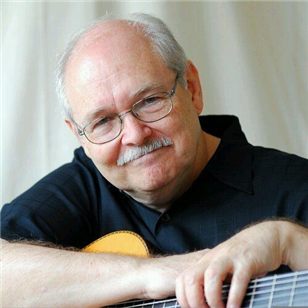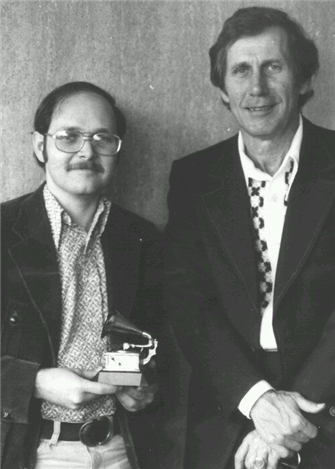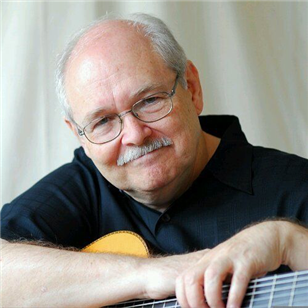Guitar by Randy Buckner
John Knowles: Part Three - Reflections
Sunday, September 8, 2019 by Randy Buckner | Method Books
Chet Atkins, The Person
Looking back, John Knowles remembers Chet Atkins as being a person who wanted to "get down to business."
When Atkins handed Knowles a guitar, he said, "Show me what you're working on" - meaning, "Let's get busy."
Atkins didn't want "to be on anybody's pedestal, he wanted to be a guitar player, and get to work."
But Atkins would also take time to make a five-year old feel special.
The day of the editing session, Atkins had a lunch appointment with - author and songwriter - Shel Silverstein.
When Shel arrived at Atkins' office, Knowles' son - Jay, who had been sitting quietly in Atkins' office - became very excited. Jay looked at his dad and said, "Don't you think we ought to sing one of our songs for Chet and Shel?"
Atkins and Silverstein sat back down, and listened to father and son sing. Atkins asked them to sing the song a second time, so he could record it on a portable cassette player.
Taking out a pen to write on the cassette, Atkins asked Jay the name of the song.
"The Gorilla Song," Jay said. Atkins asked if they wrote it. "Yes" Jay said. When asked if his name came first in the songwriting credits, the boy replied "yes."
Knowles said he knew Atkins was a good guy, but didn't know how deep it ran until he saw Jay being treated as a professional by his hero.
The Book
Coming from a background of classical guitar music - where students learned from printed music and teachers - Knowles "envisioned a day you could do the same with Atkins, Joe Pass, or Johnny Smith."
This led Knowles to become an early advocate for getting serious about publishing Atkins' music.
Knowles feels in the history of "how to" guitar books, "Chet Atkins Note-for-Note" was an early effort to take complex guitar music and have it "be the real thing instead of a fake approximation."
It's Affect on Guitarists
The first time Knowles heard someone play a song learned from the book, he almost went up and introduced himself. Instead, he thought, "next time...I'll do that, but this time is for me. So I kept that moment for myself. Next time...I'll ask what they learned from [the book]."
Knowles has been praised by musicians who say the book helped "decode" Atkins' music. For example, his harmonics, open string runs, and intricate scales like the one used in "Emily."
Final Thoughts
Knowles reflects, "It looked pretty nuts when I was doing the book. I was up all night transcribing, while teaching at a music store and community college during the day. I had no idea [the project] would lead where it's led."
"I just put my head down, did the work...looked up, and people all over the world wanted to know who John Knowles was because he wrote this book."
Knowles knew he was "gifted" with the opportunity to work with Atkins. He felt the obligation to "share what I had learned from that encounter."
Knowles hopes the project stands up over time. As he told me, "I felt I was given the chance to write the book I wish I could have bought when I was a kid."
Randy Buckner.
Hoover Music Co.
Springfield, Mo.
www.bucknerguitar.us
John Knowles: Part Two - Things Learned
Saturday, September 7, 2019 by Randy Buckner | Method Books
Nashville
After working on the project for about 10 weeks, Knowles - with wife, Becky, and son, Jay, - drove to Nashville. It was time to edit the transcriptions with Chet Atkins. During their meeting, Knowles learned many details about Atkins' technique.
The Meeting
As part of the editing process, Knowles learned the nine songs to play for Atkins. As Knowles played each tune, Atkins would occasionally stop him and say, "What are you doing there? I don't think I would do that."
Atkins then listened to the recording of the song, to remember what he had done in the studio. Knowles said, "Chet didn't ever play [a song] exactly like Chet [recorded] it."
Knowles originally thought Atkins' recordings were polished, practiced, and perfected before the recording light went on in the studio. Knowles learned Atkins would "rough out" a song, and record several versions while it was still in the thought process.
This led Knowles to theorize there were probably three or four takes of the songs, which were different from what's in the book. As Knowles said, "Pretty stunning isn't it?"
Asking Questions
Working with Atkins taught Knowles "to make as many guesses that might be right as I could - before asking the question - so I could hear the answer quickly." This also kept Knowles from wasting Atkins' time.
Knowles advises anyone who has access to a player to be as prepared as possible before they ask a question. The answer will then be heard when it comes time.
Knowles explained, "Don't ask questions you're not ready to hear the answer to. You won't get anything out of it except a photo for Facebook."
Technique
After Knowles spent time with Atkins, he learned there was a real depth to Atkins as a musician. It's a depth that's not apparent until you try to play like Atkins, and realize it's more difficult than he made it sound.
As a teen, Knowles developed theories about Atkins' technique, which were confirmed when they worked together.
Knowles learned to play by ear, so he closed his eyes and imagined what Atkins looked like as he played the guitar. Where he positioned his right hand, how his left hand was able to move so effortlessly, and so on.
Knowles was amazed at how close he had come to approximating Atkins' right hand position.
As for the left hand, Knowles spent a significant amount of time - at age 18 - "trying to figure out how to make my left hand float from one thing to another without getting too far from the fingerboard." Watching Atkins' left hand, Knowles thought, "That's it! That's what I was trying to do!"
A Teaching Text
During the project, Knowles learned how to write a text which would be helpful to a student. He realized assumptions could lead to things being left out, and a reader who still had questions.
Knowles said "the whole thing of putting [myself] in the reader's shoes is something I really learned a big dose of, and never let go of."
Randy Buckner.
Hoover Music Co.
Springfield, Mo.
www.bucknerguitar.us
John Knowles: Part One - Getting the Call
Friday, September 6, 2019 by Randy Buckner | Method Books
"That's the closest I ever came to hyperventilating." This was John Knowles' reaction when Jim Crockett asked him to write a book with Chet Atkins.
The 1975 book, "Chet Atkins Note-for-Note," was Knowles' first book published on a national scale, garnering world-wide attention for the guitar teacher from Texas.
Over the next few blog posts, Knowles will tell how the book came about, what he learned from the process, and his reflections of the book 40 years later.
Bio
John Knowles began playing the ukulele 60 years ago, but switched to the guitar after hearing a recording of Chet Atkins. Since then, Knowles has worked with Atkins, Jerry Reed, Lenny Breau, Tommy Emmanuel, and many other renowned musicians.
In 1974, Knowles' arrangement of "The Entertainer" earned Atkins a Grammy. He publishes John Knowles' Fingerstyle Quarterly, a magazine that provides guitarists around the world an opportunity to learn advanced fingerstyle arrangements from Knowles himself.
In 1968 he received a PhD in physics from Texas Christian University. In 1996, Atkins awarded Knowles the honorary title of "CGP." He has twice been inducted into the National Thumbpickers Hall of Fame.
Writing the Book
The Beginning
In the early 1970s, Knowles mailed Atkins an arrangement of "The Entertainer" after the two met in Dallas. In 1974, Knowles attended the NAMM show and met Jim Crockett, the editor of Guitar Player Magazine.
Later, Knowles received a call from Crockett. During the seven-minute conversation, Crockett told him Atkins had recorded "The Entertainer." He wanted Knowles to call Atkins and ask if he was interested in recording an album of movie themes, accompanied by a book published by Guitar Player. And, would Knowles write the book? That...was his "hyperventilating" moment.
Knowles recalled, "So I called Chet, [who] in his very calm way...laid out what he had in mind." They started by discussing song titles.
Then Knowles "got busy working on arrangements to send [Atkins]. Four ended up on the record - "Chet Atkins Goes to the Movies" - and in the book.
Before sending his arrangements to Atkins, Knowles wrote them out in pencil, to be tweaked after they were recorded. When Atkins finished recording the album, he sent Knowles a "proof" - an acetate disc of the album. Knowles listened to the album, and changed what he had penciled in to match Atkins' performances. He then transcribed the other songs on the album.
Transcribing Mr. Guitar
Knowles' process was simple. As he says, "I listened over and over, until I could slow it [the song] down in my head."
What he was listening for were "pitch clues," sounds telling Knowles on what part of the neck Atkins was playing, was there an open string in the middle of a phrase, etc.
About the process, Knowles said, "When I was learning this stuff, I wasn't trying to play [the song], I was trying to write it down." If he wasn't sure about two bars of the song, Knowles would "flag it as the tough part and move on."
After listening to the tough part, sleeping on it, and thinking about it, Knowles would then learn it at tempo, sit still, wait for it to come up on the recording, and then play along with Atkins.
Knowles was listening for musical inflections, articulations, and the sustain of notes. In his words, he "was test driving a couple of bars." There was no other way to transcribe the songs, because computer programs that allow you to slow the music down had not yet been invented.
Two Parts
As Knowles transcribed Atkins' songs, he heard two parts in the music. Knowles reasoned the best way to write down Atkins' music "was to give each part its own rhythmic continuity."
To show the polyphonic nature of Atkins' music, he borrowed the "stem up/stem down" notation learned from classical guitar music. For example, Andres Segovia's transcriptions.
By treating Atkins' music as if he were working with Segovia, Knowles feels it was "one of the things that hooked [Atkins] a little bit" into working with him on the project.
Randy Buckner.
Hoover Music Co.
Springfield, Mo.
www.bucknerguitar.us




